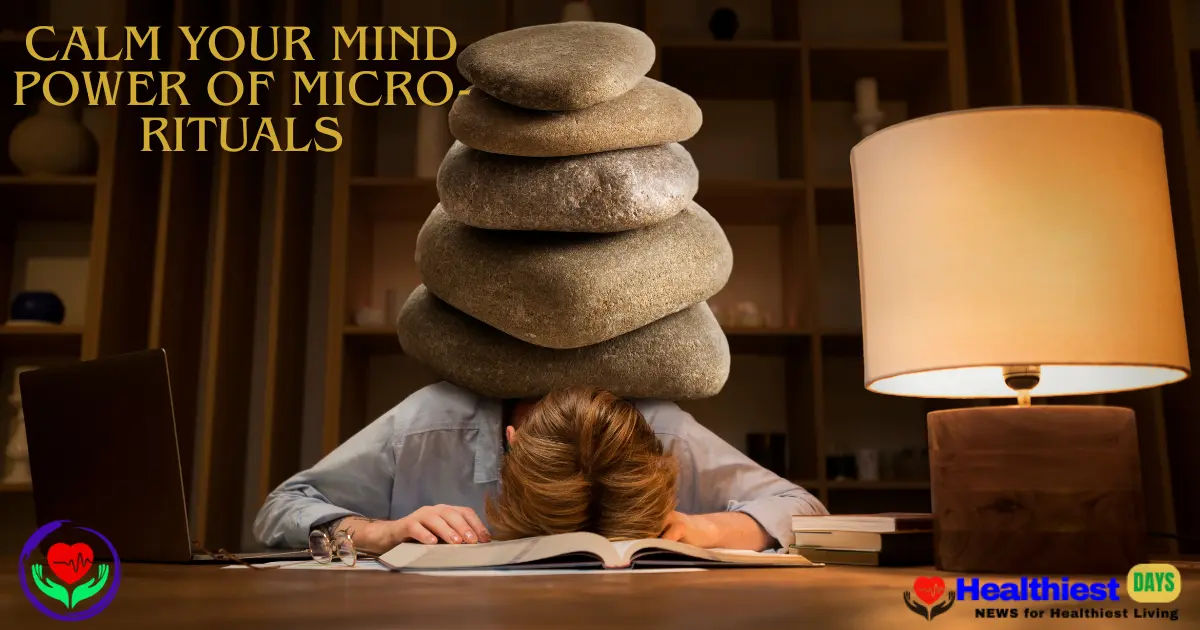How to Calm Your Mind When You are Overthinking Everything

Calm Your Mind: The Heavy Mind
There are days when your brain doesn’t stop working on how to calm your mind when you are overthinking. Thoughts race, collide, and spiral. You feel like about the situation that you’re drowning in the “what ifs,” buried under decisions, haunted by imaginary disasters. It’s not drama—it’s mental fatigue. Overthinking has become the invisible epidemic of our generation in modern times.
But here’s the truth: “You’re not alone, and you’re not broken who face the same issue.”
We are living in a world that is moving faster than we were designed to cope with; our minds are exhausted—not flawed. The ultimate purpose of this blog is not to offer quick tips or trendy distractions. It’s to walk with you through the science of your mind by offering every possible small ritual that creates real shifts. It will also empower you to choose stillness—even when your thoughts try to steal it.
Science-Backed Rituals Essential to Help You Heal Naturally and Reclaim Inner Peace: Calm Your Mind.
Why Do We Overthink? (The Brain Isn’t the Enemy)
Overthinking is not a harmful process at all. It’s a protective procedure. It must be remembered that the brain is wired to forecast danger, plan, predict, and rehearse. In evolutionary terms, but in 2025, it has clearly become a source of chronic stress, anxiety, and sleeplessness.
What’s Happening in Your Brain?
When you overthink, the default mode network (DMN) in your brain lights up and it opens the new doors of thinking and wisdom. It is a kind of mechanism that is responsible for self-referential thoughts, for example, what we did, what we might do, and what we fear others think of us. For chronic over-thinkers, the DMN is hyperactive, especially in states of fatigue or emotional depletion.
Various studies from Harvard and Yale show that over-activation of the DMN is directly rooted in anxiety, depression, and mental burnout. (Harvard Health, 2023)
The Cortisol Loop
When your worries become chronic, there is a need to understand that your body produces excess cortisol. It also keeps you in a state of hyper-vigilance. You may feel the following symptoms:
- Restlessness all the time
- Distracted from your goals
- On-edge disturbances
- Mentally “tired but wired”
It doesn’t resolve itself. It needs intentional pattern-breaking rituals and powerful shifts that deactivate the stress system within your body and restore mental clarity.
The Power of Micro-Rituals: Why 5 Minutes Can Change Everything
Many people assume that healing generally requires hour-long meditations, weekend retreats, or quitting their jobs after busy schedules of workouts. It is not true. You should realize that it is a repeatable, science-backed, and emotionally safe ritual that calms your nervous system in small but steady ways in entire domains.

Here’s what we’ll explore the following myths:
- It consists on simple breathing patterns that lower cortisol in 90 seconds
- It is self-touch and mirror techniques that rewire shame into self-worth
- It offers nature visualizations that calm the DMN
- It is also grounding tools to shift you out of mental fog
- There are some movement rituals that discharge emotional tension
Each ritual is further rooted in neuroscience, somatic psychology, and human compassion, and it is not hype at all.
Ritual #1: The “2-4-8” Breathing Reset
“When in doubt, exhale.” – Dr. Andrew Huberman
It is a kind of technique which is endorsed by neuroscience professionals because it activates your parasympathetic nervous system, the branch that helps your body rest and digest in a perfect way. Unlike the process of deep breathing, this sequence emphasizes a longer exhalation process, facilitating the carbon dioxide to come out, which signals to the body that you are safe.
How to Do It to Calm Your Mind:
- There is a need to inhale through your nose for 2 seconds
- You must hold your breath gently for 4 seconds
- You should exhale through pursed lips for 8 seconds
- There is a need to repeat for 5 rounds
You may have chances to feel a light buzz or warmth in your chest. It is a vagal stimulation. It means that your stress switch is turning off; it can be found anywhere before meetings, during a panic episode, or as part of your bedtime ritual.
Ritual #2: Self-Compassion in the Mirror
Self-criticism fuels overthinking by creating a series of questions which you cannot answer properly. It creates an inner environment of fear, threats, and judgment without any reason. As research from the University of Texas shows, magical results are that self-compassion can reduce anxiety by up to 50% over time.
The ritual can be ended in the given way:
- You must stand in front of a mirror.
- There is a need to place your hand on your chest or cheek.
- Look confidently into your own eyes. Say aloud:
- “I am completely safe now.”
- “I forgive myself for not having all the answers in my soul.”
- “I am doing the best I can do for me.”
Many times, it may feel awkward. Your nervous system will remember the kindness act which you did for yourself, even if your ego resists it.
Ritual #3: Forest in the Mind—Guided Visualization
Imagine a situation where nature, especially trees, water, and light, has been proven to lower blood pressure. It reduces cortisol and even enhances your immune function. There is no need to understand yourself as a forest. You need 2 minutes of silence and a sensory-rich imagination.
Try this to beat the ritual:
- Close your eyes for some minutes.
- Imagine a situation in which you are walking through a pine forest.
- Feel your feet are on soft moss.
- Hear the birds closely.
- Smell the earth after rain and feel it.
Do this entire process for just 120 seconds. Your brain is not capable of distinguishing between real and imagined safety. You are literally reprogramming stress into serenity for getting peace in your life.
Ritual #4: The 5 4 3 2 1 Grounding Method to calm your mind
Such kinds of cognitive behavioral therapy (CBT) tools work fast for anxiety and rumination. It brings signals to the brain from abstract fear to concrete reality.
How to do it:
- 5 things you can see, including light, shadow, a desk, and your hands
- 4 things you can feel the following things (fabric, cool air, floor under feet)
- 3 things you can hear, as you should remember (buzz of electronics, cars, breath)
- 2 things you can smell at least
- 1 thing you can taste
This practice grounds you in the said situation. It also reminds your brain, “I am not in danger. I am here for you.”
Ritual #5: One Song, One Minute of Movement
Trauma, stress, and anxiety are the constant things that live in the body. Remaining alone doesn’t release them in your mind. But rhythmic movement, and even just 60 seconds, can certainly regulate your nervous system and shift your emotional state in an amazing way.
Try the tips:
- You must put on one calming or energizing song (choose based on your state)
- For various types of stretch, sway, or dance—no rules
- Let your body lead you naturally
It isn’t a workout; rather, it’s a nervous system reset.
The Science Behind These Rituals
These are not gimmicks and tricks, yet they are very ritualistic here:
- You must activate the vagus nerve, lowering your heart rate
- It interrupts overactive DMN cycles that fuel overthinking
- It also increases dopamine and oxytocin, neurochemicals of hope and connection
They collectively work because they’re “new,” they’re natural and repeatable, and they’re aligned with how the human body was made to heal and calm your mind.
How to Turn These Into Lifelong Habits
Consistency has the capacity to create calm—not intensity.
Start with one ritual per day, at the same time, and follow the given tips with caution:
- After brushing your teeth, then start your way
- Before lunch, you can go for it
- Before bed, you can try for it
There is also narration that it should stack the ritual with an existing habit (called “habit anchoring” by Dr. BJ Fogg). With the passage of time, your brain will crave the calm because you’ve taught it that peace is familiar. To calm your mind when you are overthinking everything, you are in charge of bringing change in you; just be determined.
FAQs
Q1: Can self-care replace therapy or medication?
Definitely not. Such kinds of all rituals support healing but don’t replace medical care. If you’re struggling with them, you are directed to talk with a mental health professional.
Q2: I don’t have time. Do 5 minutes really help?
Yes. Even 90 seconds are enough to focus breathing, yet it can reduce cortisol. It is noted that your body remembers every act of safety.
Q3: What if I don’t feel anything?
Yes, it is all right because healing isn’t about instant feelings. It’s about repetition. Keep showing up. Trust builds over time.

You Deserve Peaceful Recovery
You don’t have to wait for a certain crisis to reclaim your peaceful recovery. There is no need to fix everything to deserve rest. These rituals are your proper invitation to come home to yourself, not someday, but you can get rid of them now.
At HealthiestDays, we truly believe in healing naturally because you deserve clarity, calm your mind, and care without the possible harm of side effects.
Let it be the start of a moment you chose for a new relationship with your mind. It does not as a battlefield, but as a home for natural recovery.



